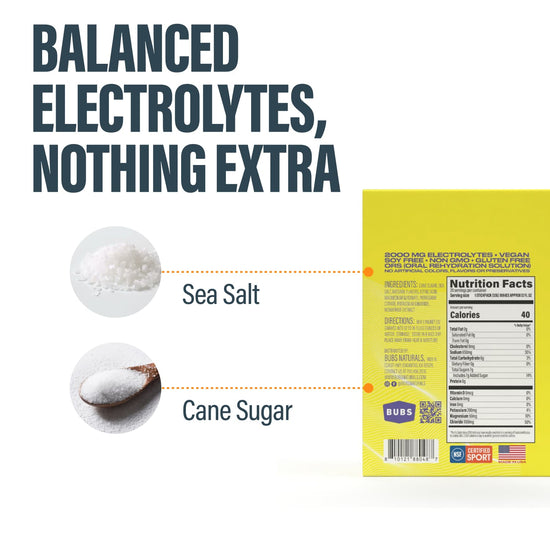Table of Contents
- Introduction
- Understanding Leg Cramps
- How Electrolytes Can Help with Leg Cramps
- Practical Tips for Managing Leg Cramps
- Conclusion
- FAQ
Leg cramps can strike at the most inconvenient times—during a workout, while relaxing at home, or even in the middle of the night. If you've ever experienced the sudden and painful tightening of your calf muscles, you might be wondering about the potential role of electrolytes in alleviating these cramps. Are electrolytes the key to preventing or treating leg cramps? In this post, we’ll delve into the relationship between electrolytes and leg cramps, explore the scientific backing behind it, and provide practical insights to help you manage leg cramps effectively.
Introduction
Have you ever been jolted awake at night by a painful cramp in your leg? Or perhaps you've felt the debilitating grip of a cramp while running or exercising? You're not alone. Muscle cramps are a common issue that affects millions of people, especially athletes and those engaged in regular physical activity. Although the exact causes of leg cramps remain somewhat of a mystery, factors such as dehydration, muscle fatigue, and electrolyte imbalances are often cited as potential culprits.
Historically, athletes have relied on sports drinks rich in electrolytes to maintain hydration and muscle function during intense workouts. But do these drinks really make a difference when it comes to preventing or alleviating leg cramps? In this blog post, we’ll explore the role of electrolytes, the science behind muscle cramps, and how our supplements—particularly our Hydration collection—can support your wellness journey.
Understanding Leg Cramps
What Are Leg Cramps?
Leg cramps, often referred to as "charley horses," are sudden, involuntary muscle contractions that can cause intense pain. These cramps can last for a few seconds to several minutes, often leaving the affected muscles feeling sore afterward. While cramps can occur in any muscle, they are most commonly experienced in the calf muscles.
Causes of Leg Cramps
The causes of leg cramps are multi-faceted and can include:
- Dehydration: Loss of fluids during physical activity can lead to muscle cramps. When you sweat, you also lose electrolytes—minerals that play a crucial role in muscle contraction and relaxation.
- Electrolyte Imbalances: Electrolytes such as sodium, potassium, calcium, and magnesium help regulate muscle function. An imbalance in these minerals can trigger muscle cramps.
- Muscle Fatigue: Overexertion or prolonged physical activity can lead to fatigue in the muscles, increasing the likelihood of cramping.
- Nerve Compression: Conditions such as spinal stenosis can compress nerves, leading to muscle cramps.
Understanding these triggers is essential in addressing the issue effectively.
The Role of Electrolytes in Muscle Function
Electrolytes are minerals that carry an electric charge and are vital for numerous bodily functions, including muscle contraction and nerve signaling. The key electrolytes relevant to muscle function include:
- Sodium: Helps maintain fluid balance and is crucial for muscle contractions.
- Potassium: Essential for muscle relaxation and contraction; low potassium levels can lead to increased cramping.
- Calcium: Plays a pivotal role in muscle contraction. Insufficient calcium can impair muscle function and lead to cramps.
- Magnesium: Important for muscle relaxation and helps prevent excessive contraction.
Given that electrolyte imbalances can lead to muscle cramps, replenishing these minerals may help alleviate or prevent cramping episodes.
How Electrolytes Can Help with Leg Cramps
The Science Behind Electrolytes and Cramps
Research indicates that adequate hydration and electrolyte balance can help reduce the likelihood of leg cramps during exercise. For example, one study found that consuming a carbohydrate-electrolyte beverage before and during exercise delayed the onset of exercise-associated muscle cramps (EAMCs) in some individuals. This suggests that replenishing lost electrolytes may provide a buffering effect against cramps, allowing for prolonged physical activity without the interruption of painful spasms.
Best Sources of Electrolytes
While sports drinks are often marketed for their electrolyte content, there are plenty of natural sources that can help maintain your electrolyte levels:
- Coconut Water: A natural electrolyte-rich beverage that contains higher potassium levels than many sports drinks.
- Bananas: Well-known for their potassium content, bananas are a convenient snack that can help prevent cramps.
- Leafy Greens: Spinach and kale are excellent sources of calcium and magnesium.
- Nuts and Seeds: Almonds and pumpkin seeds provide magnesium, which is crucial for muscle relaxation.
- BUBS Naturals Hydration: Our Hydration collection includes electrolyte drinks that are NSF Certified for Sport, ensuring they are free from banned substances and are effective in replenishing electrolytes lost through sweating.
To explore our Hydration collection and see how it can support your wellness journey, check it out here.
Practical Tips for Managing Leg Cramps
Staying Hydrated
Maintaining proper hydration is essential for preventing muscle cramps. Aim for:
- Regular Water Intake: Drink water throughout the day, especially before, during, and after exercise.
- Electrolyte Drinks: Consider incorporating electrolyte drinks, like our Hydration collection, into your routine to replenish lost minerals.
Stretching and Conditioning
Incorporating stretching into your fitness routine can help condition your muscles and prevent cramps. Focus on:
- Dynamic Stretching: Before workouts, engage in dynamic stretches to prepare your muscles.
- Static Stretching: After workouts, perform static stretches to enhance flexibility and reduce muscle tension.
Nutrition Matters
A well-balanced diet rich in electrolytes can support muscle health. Consider:
- Potassium-Rich Foods: Include bananas, potatoes, and avocados in your meals.
- Magnesium Sources: Incorporate nuts, seeds, and whole grains into your diet.
Rest and Recovery
Allow your muscles to recover adequately between workouts. Fatigue can increase the risk of cramps, so ensure you:
- Listen to Your Body: Avoid pushing through fatigue during workouts.
- Get Enough Sleep: Quality sleep supports muscle recovery and overall wellness.
Conclusion
Leg cramps can be a frustrating and painful experience, but understanding their causes and the role of electrolytes can empower you to take control. By staying hydrated, maintaining a balanced diet rich in electrolytes, and using effective supplements like our Hydration collection, you can reduce the likelihood of cramps and support your active lifestyle.
To discover how our Hydration collection can enhance your wellness journey and help tackle leg cramps, visit us here. Remember, a proactive approach to hydration and nutrition can make all the difference in your performance and comfort.
FAQ
1. What are the most common causes of leg cramps?
The most common causes include dehydration, electrolyte imbalances, muscle fatigue, and nerve compression.
2. How do electrolytes help prevent leg cramps?
Electrolytes help regulate muscle contractions and relaxation. An imbalance in these minerals can lead to increased cramping during physical activity.
3. Can I get enough electrolytes from food alone?
Yes, many foods are rich in electrolytes, including fruits, vegetables, nuts, and legumes. However, during intense exercise, electrolyte drinks can provide a quick replenishment.
4. What should I do when a leg cramp occurs?
To alleviate a leg cramp, try gently stretching the affected muscle, massaging it, or applying heat. Staying hydrated and maintaining electrolyte balance can help prevent future cramps.
5. When should I seek medical advice for leg cramps?
If you experience frequent, severe leg cramps that disrupt your daily life or are accompanied by swelling, numbness, or changes in skin color, consult a healthcare professional for evaluation.
Written by:
Bubs Naturals

Hydrate or Die
When you’re sweating hard—whether it’s from a tough workout, a long day in the sun, or just life—your body needs more than water to stay balanced and energized.
Hydrate or Die® delivers 2,000 mg of electrolytes in every serving to help you rehydrate faster, fight off fatigue, and keep going strong. That includes the right mix of sodium, potassium, and magnesium to support muscle function, prevent cramps, and maintain energy levels.
With a small dose of natural cane sugar to speed up absorption, this clean, easy-to-use powder is made for real performance—not just flavor.
Starts at $29.60
Shop

